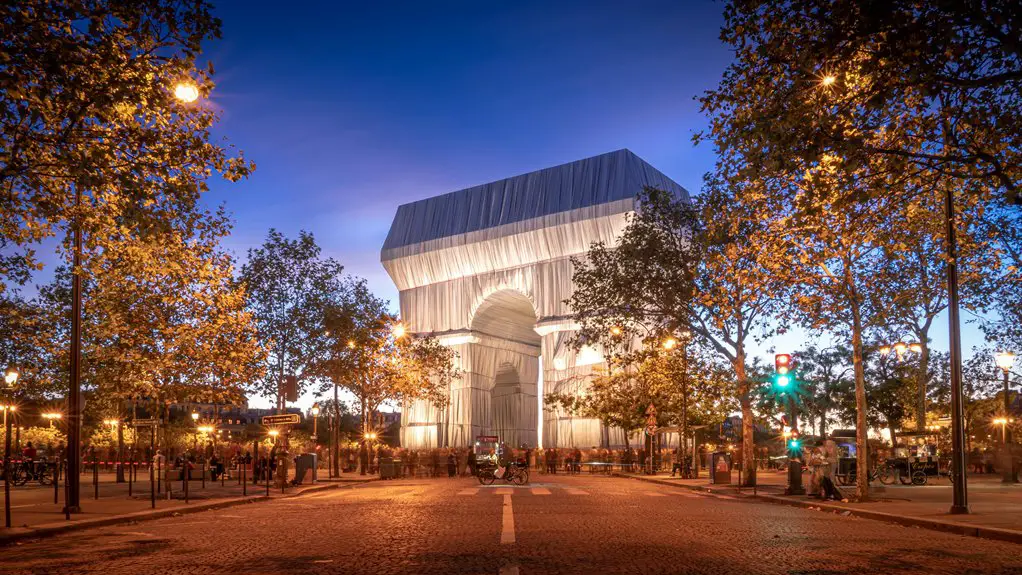You can create stunning large-scale art installations using scrim fabric because it’s lightweight, durable, and plays beautifully with light and shadow. Stretch or pleat scrim to add texture, then use layered or colored lighting to craft dynamic visual effects and depth. Plan carefully for support structures and fabric needs to guarantee stability and scale. Proper maintenance keeps your installation vibrant and lasting. Keep exploring to discover techniques and tips that bring your creative vision fully to life.
Table of Contents
Key Takeaways
- Select lightweight, translucent scrim fabric for versatile, durable large-scale installations that interact well with light and shadow.
- Stretch and mount scrim tightly over sturdy frames, using pleats or layered sections to enhance texture and visual depth.
- Plan lighting carefully, adjusting angles and colors to create dynamic shadows and highlight the scrim’s translucency.
- Accurately measure the installation space and design stable support structures to maintain fabric tension and safety.
- Perform regular maintenance including gentle cleaning, UV protection, and hardware checks to ensure longevity and appearance.
Benefits of Using Scrim Fabric in Art Installations
When you use scrim fabric in your art installations, you gain versatility that few other materials offer.
This lightweight, translucent fabric allows you to play with light and shadow, creating dynamic visual effects that can transform any space. You can easily layer scrim to add depth or use it as a projection surface to integrate multimedia seamlessly.
Its durability means it withstands repeated handling and outdoor conditions without losing shape or texture. Plus, scrim’s flexibility lets you shape large-scale forms without heavy support structures, saving time and effort.
Whether you want subtle visual intrigue or bold architectural statements, scrim fabric adapts to your creative needs while keeping your installation manageable and impactful.
This material truly elevates your artistic possibilities.
Techniques for Manipulating Scrim Fabric
Several effective techniques can help you manipulate scrim fabric to achieve striking effects in your art installations.
First, stretching the fabric tightly over frames creates smooth, taut surfaces that enhance visual impact. You can also pleat or gather scrim to add texture and depth, adjusting folds to control translucency.
Sewing or bonding multiple layers lets you play with opacity, enabling subtle shifts in appearance. Cutting scrim into shapes or patterns allows for custom designs and dynamic compositions.
Additionally, mounting scrim at various distances from surfaces introduces dimensionality and movement as viewers change perspectives.
Experiment with tension and layering to discover how scrim reacts, giving you full control over your installation’s look without compromising its lightweight, flexible nature.
These techniques open up endless creative possibilities.
Integrating Light and Shadow With Scrim
Although scrim fabric offers unique textural qualities, its true potential shines when you integrate light and shadow into your installation.
You can manipulate light sources behind or in front of the scrim to create dynamic visual effects, enhancing depth and atmosphere. By adjusting the intensity and angle of light, you’ll cast intricate shadows that interact with the scrim’s semi-transparent surface, producing layered compositions.
Experiment with colored lighting to add mood or emphasize specific areas, transforming the fabric into a living canvas. Remember, the fabric’s translucency allows you to play with both direct illumination and silhouette effects, giving your installation an enchanting, ever-changing presence.
Thoughtful light placement will elevate your piece, making the interplay of light and shadow a central storytelling tool.
Planning and Scaling Large Scrim Installations
Because large scrim installations demand careful coordination, you’ll need to plan every detail from materials to space requirements before starting.
Begin by mapping out the installation site and measuring available space accurately. Next, calculate the scrim fabric needed, considering overlap and tension for stability. Factor in access points for installation and maintenance. Consult with structural engineers if your design involves hanging or tensioning systems to guarantee safety.
Finally, create a timeline that accounts for fabrication, transport, and installation stages.
Key planning steps include:
- Evaluating space dimensions and environmental conditions
- Calculating precise fabric quantities
- Designing support and hanging structures
- Coordinating logistics and transportation
- Scheduling installation phases with a clear timeline
This thorough planning guarantees your large scrim piece fits perfectly and stands securely.
Maintenance and Durability Considerations for Scrim Art
Once your scrim installation is in place, maintaining its appearance and functionality becomes a priority. You’ll want to regularly inspect the fabric for tears, dirt, or fading, especially if it’s exposed to outdoor elements.
Clean your scrim gently using mild soap and water, avoiding harsh chemicals that can weaken the fibers. Address any minor damage immediately to prevent it from worsening—small tears can be patched or reinforced.
UV protection treatments can help prolong color vibrancy and material strength if your installation faces direct sunlight.
Also, check the mounting hardware to guarantee it remains secure and doesn’t strain the fabric.
Frequently Asked Questions
Where Can I Purchase High-Quality Scrim Fabric for Art Projects?
You can find high-quality scrim fabric at specialty textile stores, online marketplaces like Amazon or Etsy, and theatrical supply shops. Don’t forget to check fabric wholesalers for bulk orders if you need larger quantities.
What Are the Environmental Impacts of Using Scrim Fabric?
You should know scrim fabric’s environmental impact depends on its material—synthetic types can shed microplastics and aren’t biodegradable, while natural fibers are more eco-friendly but less durable. Always consider sourcing sustainable options to reduce harm.
Can Scrim Fabric Be Recycled After an Installation Ends?
Think of scrim fabric like a stage curtain—it can be reused or recycled, but it depends on its material. If it’s polyester, you can recycle it, so don’t toss it; give it a second act instead!
What Safety Precautions Are Needed During Large Scrim Installation Setups?
You’ll need to wear protective gear, secure scaffolding, and guarantee proper rigging. Always check weather conditions, follow weight limits, and have a clear communication plan with your team to prevent accidents during large scrim setups.
How Do I Transport Large Scrim Fabric Pieces Without Damage?
Think of rolling your scrim like a scroll from ancient times—carefully and tightly. You’ll want to use protective sleeves, avoid sharp folds, and secure the fabric during transport to prevent tears, dirt, or wrinkles.
- Recycling Nonwoven Fabrics: Is It Possible? - July 11, 2025
- Recycling Nonwoven Fabrics: Is It Possible? - July 11, 2025
- Recycling Nonwoven Fabrics: Is It Possible? - July 11, 2025







